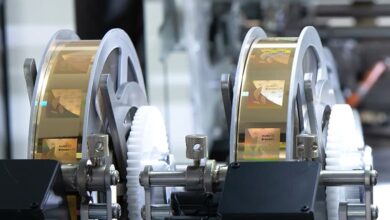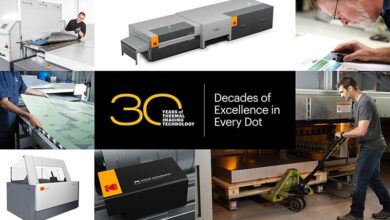Innovation is at the Heart of Our DNA
Interview with Thorsten Kröller, President, Division ACTEGA

If you work in this industry, I am sure you have heard of the P provider that is ACTEGA. But how much do you really know about this technology-leading company? When and how did it all begin? What is their company philosophy and how does that translate into product development and market focus? What is their vision for the future?
We spoke to the person best placed to answer these questions – Thorsten Kröller, President, Division ACTEGA – and here is what he told us.
Firstly, who is ACTEGA and what does it specialize in?
We’re an innovative specialty chemicals business with a focus on products for the packaging and printing industries. We offer a comprehensive range of specialty and standard solutions for the packaging and print industry, spanning numerous sectors of the market, including flexible packaging and labels, folding cartons, or metal packaging.
We invest in sustainable products and new technologies that can change our industry. We understand that the most impactful solutions need to deliver value to our customers while enabling them to be responsible stewards of our natural resources. To achieve this, we reinvest 10% of our annual sales into Research and Development.
We also pride ourselves on contributing towards end products that enable brands and consumers to have a greater connection due to the “look and feel” of the packaging, or its environmental credentials, while also ensuring good economics throughout the entire packaging and printing value chain.
Legally compliant product solutions, specially tailored to the high safety standards of the food and pharmaceutical industries determine our innovation roadmap and activities. However, at ACTEGA, we do not only want to be compliant, we want to further expand our regulatory leadership especially in regards to sustainability.
When was ACTEGA established, and has it always been an ALTANA business?
ACTEGA actually consists of 10 companies, each founded in different years and regions with different business focuses, but all with a well-established, experienced offering. When ALTANA redefined itself in 2007 as a pure specialty chemicals company with four divisions, ACTEGA Coatings & Sealants was established. Now only referred to as ACTEGA, we develop, produce, and sell a broad portfolio of specialty coatings, inks, adhesives and sealing compounds. We own production sites in Europe, North and South America and China, as well as numerous technical service centres and sales offices all over the world. To provide the right solutions for the packaging and printing industry, ACTEGA is much more than the sum of its parts. It is a cross-functional and globally oriented organization that enables us to exploit synergies and optimally serve the interests of our customers.
What does ACTEGA stand for, and what are its core values and business personality?
Good question and one that we revisit a lot. In summary, our approach to business mirrors our commitment to innovation, regulatory compliance, customer centricity and sustainability, with many of our latest solutions having been developed to help support a more efficient, and sustainable future for the industry. This is paramount. The beauty of ACTEGA is that we’re able to be truly agile – we not only know our customers, but we have the flexibility to be able to develop our products in tandem with them to ensure that we deliver what they need. We stand for a global presence but offer dedicated local services that help us maintain that important connection to the market; it is at the heart of who we are.
So, why is sustainability such an important focus for ACTEGA?
Put simply, because it is the right thing. For us it is not enough to just be compliant, we want to move the needle today, to effect change now – but we also want to support a long-term sustainable future.
More widely, ALTANA has made a commitment to be climate neutral by 2025. This commitment, and ambitious goal, has filtered down to the culture, working practices and products within ACTEGA too. Our approach to sustainability is now truly holistic, and we consider its impact not only on the environment, but human health, social engagement, and economics too.
One of the first steps for us towards meeting our sustainability objectives was to push the regulatory envelope. This means achieving customer accreditations, awards and certifications for food safety, and environmental best practice. Recently our ACTEGA company in Switzerland has been awarded a Platinum EcoVadis Medal which places us among the top 1 percent of companies assessed by EcoVadis in regards to their sustainability ratings.
An additional achievement was our entire FoodSafe series being awarded the Gold level Material Health Certificate by the Cradle to Cradle Products Innovation Institute. This prestigious Gold level certification provides customers with further confidence in the safety of ACTEGA’s complete FoodSafe portfolio, enabling them to offer brands packaging solutions that adhere to the highest material health requirements for coatings based on European legislation.
The other element to our approach that allows us to demonstrate our commitment to sustainable solutions, is our investment in R&D and focus on innovation. Of course, innovation plays an important role for ACTEGA in other areas of our business philosophy, but sustainability is a key focus here too and it is often at the forefront of our most recent and future projects in development.
Our ACTGreen® Barrier Coatings is a perfect example of this. These coatings are a range of advanced water-based barrier coatings and next generation elastomer dispersions that enable substrates to be widely and easily recycled utilizing standard practices.
Part of the ACTGreen® portfolio also includes the first and only PVC-free and plasticizer-free sealing compounds for food packaging. ACTGreen® Sustainable Compounds, including the brand PROVALIN®, are blends of carefully selected thermoplastic elastomers and fulfil all requirements regarding safe and eco-friendly packaging.
What do you consider to be the key trends in the packaging industry today?
Despite the challenges of the pandemic during the past couple of years, solutions that enable increased sustainability and recyclability of end products continue to be the biggest trend we see. That’s largely because those elements are at the heart of corporate responsibility programmes for manufacturers like us, as well as our printer and converter customers, and the brands they serve.
There is also another reason why sustainability is a big business focus for many, and that’s regulation. A really good example of this is the market transition from conventional UV inks to UV LED. The switch to UV LED inks has many benefits, but improved sustainability is a big one. Stricter regulations banning the use of chemicals for UV products is putting label converters under pressure to adapt quickly to more sustainable production methods.
Another trend that continues to grow is the use of haptic effects for packaging premiumization. These coatings and varnishes are used to enhance the consumer experience, by adding relief effects or soft touch surfaces, for example, to applications like shrink sleeves, tubes or folding cartons, making the packaging more impactful and engaging, and ultimately driving sales.
Knowing this and working with our customers, we developed the world’s first ‘soft touch’ effect decorative coating for laminate tubes. This water-based dual cure solution solves the previous issues of long-term scratch, abrasion and stain resistance associated with soft touch effects on laminate tubes. It now provides manufacturers of laminate and extruded tubes with a brand-new revenue stream to diversify their business.
Lastly, for our industry to succeed long term, waste reduction is a key issue that must be addressed. To achieve that, we believe that the whole industry needs to come together and act as one, with other key vendors and suppliers making packaging sustainability a key pillar of their business too.
How else does ACTEGA’s focus on innovation impact the way in which the company operates?
As mentioned, it’s at the heart of our DNA, so we invest heavily in the development of new technologies that could change the packaging industry. Our core R&D groups are all leaders in their fields, and we also have several long-term university and brand owner partnerships too. These enable us to push new boundaries, test and develop the latest game-changing solutions that could impact the market and take us closer to our vision for a more sustainable, effective, and innovative industry.
There are new technologies that, for example, combine sustainability with high-quality product decoration. A good example is ECOLEAF, a sustainable metallization technology that significantly reduces economic barriers, such as material and waste and offers increased production flexibility compared to today’s conventional processes that are mainly foil-based.
SigniteTM is another great example of a new technology that enables brands to achieve more from their product decorations. Through a unique printing process and the way decorations are applied on containers, SigniteTM decorations produce significantly lower waste than traditional pressure sensitive labeling, with improved design flexibility when compared to direct-to-container screen printing. All while improving recyclability and reuse capabilities.
How does collaboration and feedback from customers affect your innovation?
Collaboration is crucial to our business. As mentioned, we rely on customer feedback to better understand what the market wants and needs. To achieve that, we work with our regional teams and their network of valued customers and partners around the world. Collaborating with customers encourages or deters the development of our innovations into commercially available products. This process is invaluable to us, and for customers, it ensures that they have a hand in steering our R&D process towards innovations that will only have a positive impact on their business.
Tell us more about the current ACTEGA product ranges.
For me, this is the fascinating thing about our business. Our portfolio is so extensive and our customer base so broad, that billions of people come into contact with our products every day – whether that’s in the form of barrier coatings on cartons, inks on labels, adhesives on blister packaging, PVC free compounds for metal vacuum closures, or water-based sealants for can ends.
Increasingly for many big brands, a supplier offering a broad portfolio of products and supply chain efficiencies, is of high value to their business. This is why working with ACTEGA resonates with them.
From an ACTEGA perspective, what’s next for the business?
Of course, we are always working on several innovations at the same time, talking to customers and brands to ensure that we understand the latest trends that impact them – whether that be in changes to consumer behavior, or in the need to make packaging more engaging to achieve shelf stand-out. However, it’s our long-term goal to further diversify and innovate our product portfolio while working to achieve our sustainability goals.
We are very fortunate that in our industry, we are also able to play a role in the sustainability of packaging, while also supporting the protection of food, simplifying the recycling process and caring about waste reduction.
What are the key opportunities for the business in the next 12 months?
In short, simply to unlock the potential of our innovative technologies and increase their market adoption. Whether they be in the market already, progressing in R&D or waiting to launch, we genuinely believe that we have some world leading, truly transformative customer solutions that will make a real contribution to the success of our customers’ businesses. In addition, we will increase our engagement in selected regions, such as Southeast Asia and China, to get closer to our customers.

.gif)



